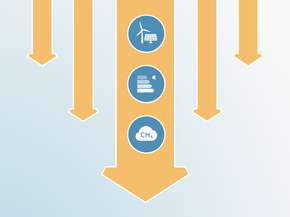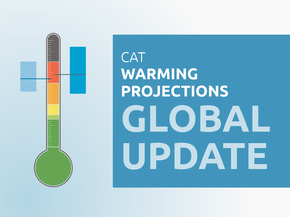Country summary
Overview
This assessment includes our policy analysis from 22 September 2020 translated into our new rating methodology without new analysis of South Africa’s climate policies since then. The announcement of a new NDC target by the Presidential Climate Commission of March 2021 is mentioned but not included in our calculations. We will fully analyse South Africa in the coming months and the rating may change.
The CAT rates South Africa’s climate targets and policies as “Insufficient”. The “Insufficient” rating indicates that South Africa’s climate policies and commitments need substantial improvements to be consistent with the Paris Agreement’s 1.5°C temperature limit.
South Africa’s 2030 emissions reduction target is rated as “Insufficient” when compared to modelled domestic pathways, and “Highly insufficient” when compared with its fair-share contribution to climate action. South Africa’s targets and policies are not stringent enough to limit warming to 1.5°C. If fully implemented, South Africa’s current policies would result in emissions reductions only in line with 3°C warming.
In June 2021, the Presidential Climate Commission recommended that the country's NDC be strengthened to 350-420 MtCO2e (incl. LULUCF), see our analysis here for details. The lower end of this range proposed by the Presidential Climate Commission is close to being 1.5°C compatible and will be integrated into our next assessment.
The government has introduced several support programmes and emergency funds in direct response to the immediate COVID-19 health and economic crisis.
Prior to the pandemic, the South African Cabinet finally approved the long-awaited Integrated Resource Plan (IRP2019) in October 2019. The final plan marks a major shift in energy policy away from coal towards renewables, which is remarkable for a coal-dominated country like South Africa.
We rate South Africa’s policies and actions as “Almost sufficient”. The “Almost sufficient” rating indicates that South Africa’s climate policies and action in 2030 are not yet consistent with the Paris Agreement’s 1.5°C temperature limit but could be, with moderate improvements. If all countries were to follow South Africa’s approach, warming could be held at—but not well below—2°C.
The full policies and action analysis can be found here.
We rate the proposed 2030 reduction target levels as “Insufficient” when compared modelled emissions pathways. The “Insufficient” rating indicates that South Africa’s domestic target in 2030 needs substantial improvements to be consistent with the Paris Agreement’s 1.5°C temperature limit. If all countries were to follow South Africa’s approach, warming would reach over 2°C and up to 3°C.
Our methods do not provide a clear answer for the need for finance for South Africa. On balance, the CAT methodology shows that provision of a small but important amount of international support is consistent with the wide range of literature on fair share contributions to meeting the Paris Agreement's goals. However, South Africa currently relies on foreign investments and international finance support to implement a large percentage of its climate change programmes, and government also emphasises in its NDC, that the implementation of its NDC will be enabled by financial support as specified in the Paris Agreement.
We rate South Africa’s 2030 NDC target as “Highly insufficient” when compared with its fair-share contribution to climate action. The “Highly insufficient” rating indicates that fair share target in 2030 leads to rising, rather than falling, emissions and is not at all consistent with the Paris Agreement’s 1.5°C temperature limit. If all countries were to follow South Africa’s approach, warming could reach over 3°C and up to 4°C.
The CAT interprets the full NDC target as unconditional. As South Africa only needs to reach its upper end of the target range to fulfil the NDC, we rate that emissions level. If South Africa committed to meeting the lower end of its target range, the rating would change to “Almost sufficient” when compared to modelled domestic pathways, and to “Insufficient”, but close to the border to “Almost sufficient”, when compared to the fair share contribution.
The CAT currently does not evaluate South Africa’s net zero target given the preliminary nature and a lack of more detailed information. The CAT will do so once further information will be communicated by the government.
Further analysis
Latest publications
Stay informed
Subscribe to our newsletter




